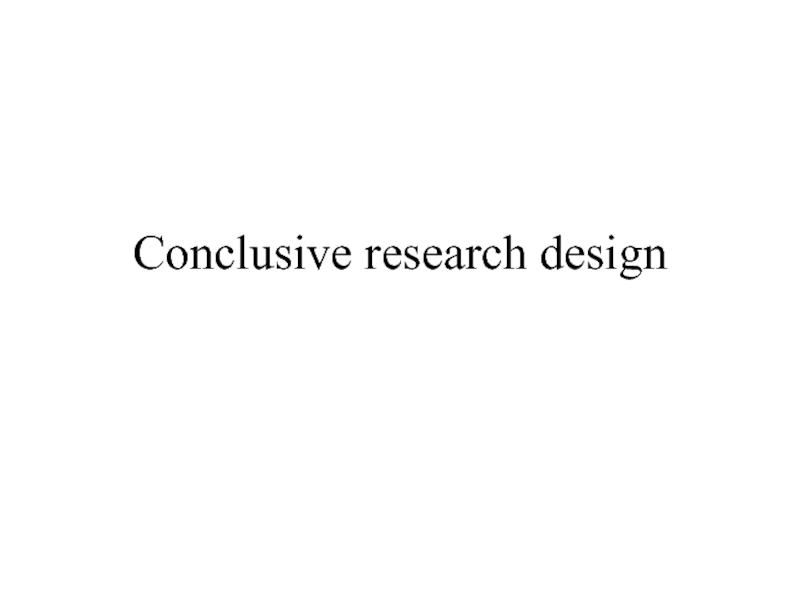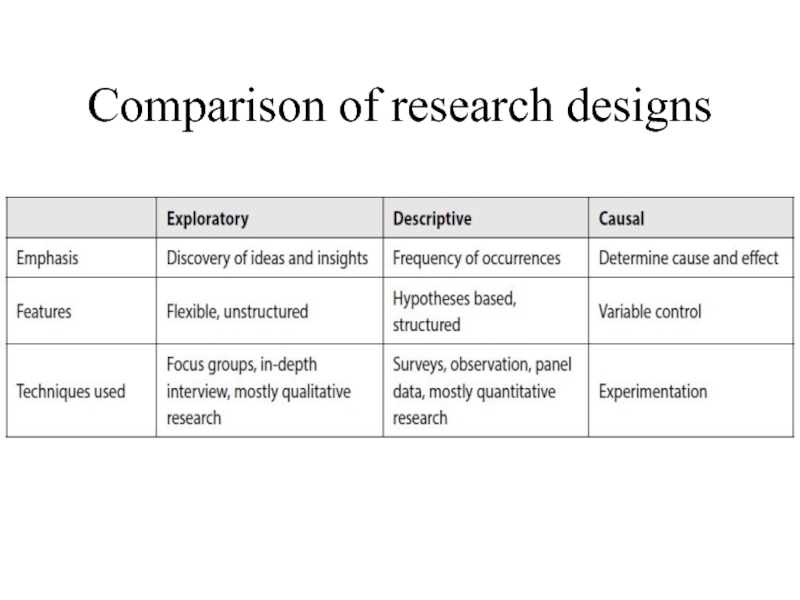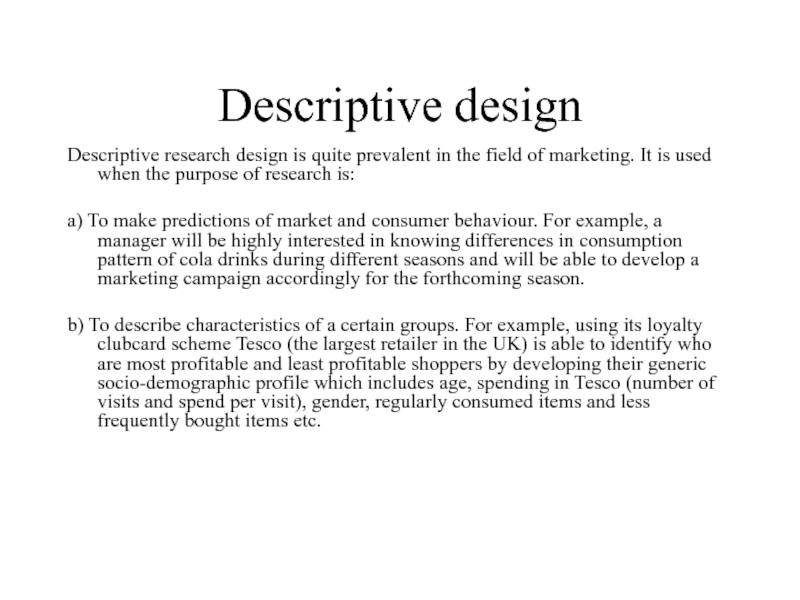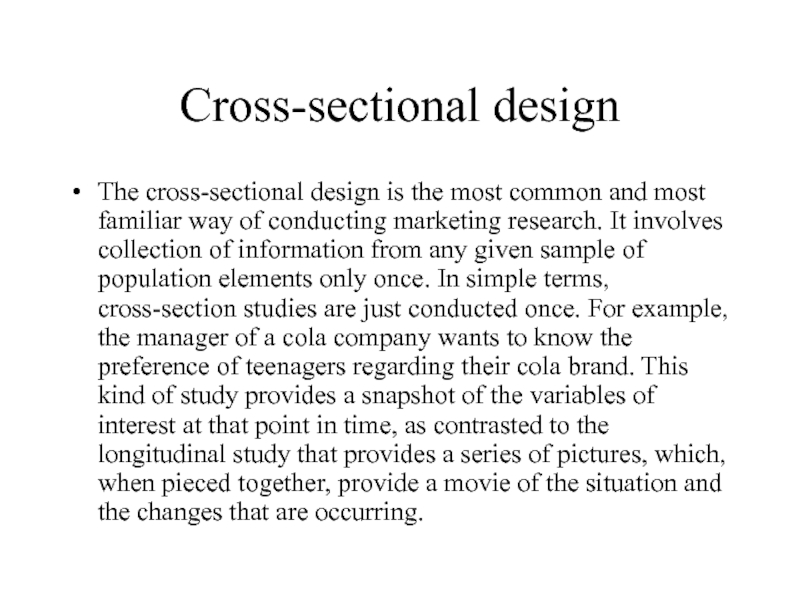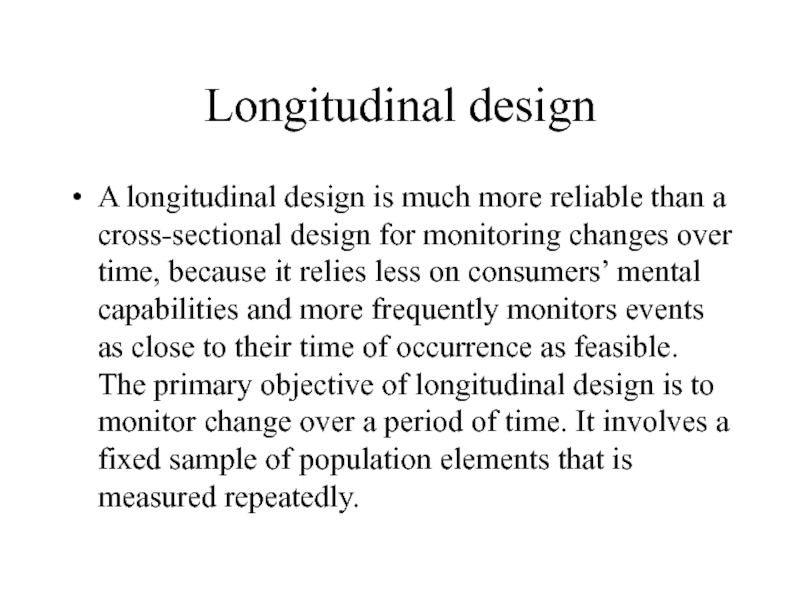- Главная
- Разное
- Дизайн
- Бизнес и предпринимательство
- Аналитика
- Образование
- Развлечения
- Красота и здоровье
- Финансы
- Государство
- Путешествия
- Спорт
- Недвижимость
- Армия
- Графика
- Культурология
- Еда и кулинария
- Лингвистика
- Английский язык
- Астрономия
- Алгебра
- Биология
- География
- Детские презентации
- Информатика
- История
- Литература
- Маркетинг
- Математика
- Медицина
- Менеджмент
- Музыка
- МХК
- Немецкий язык
- ОБЖ
- Обществознание
- Окружающий мир
- Педагогика
- Русский язык
- Технология
- Физика
- Философия
- Химия
- Шаблоны, картинки для презентаций
- Экология
- Экономика
- Юриспруденция
Conclusive research design презентация
Содержание
- 1. Conclusive research design
- 2. Comparison of research designs
- 3. Descriptive design Descriptive research design is quite
- 4. Cross-sectional design The cross-sectional design is the
- 5. Longitudinal design A longitudinal design is much
- 6. Causal designs Causal research is most appropriate
- 7. Survey methods personal interviews; telephone interviews; mail interviews and online interviews
Слайд 3Descriptive design
Descriptive research design is quite prevalent in the field of
marketing. It is used when the purpose of research is:
a) To make predictions of market and consumer behaviour. For example, a manager will be highly interested in knowing differences in consumption pattern of cola drinks during different seasons and will be able to develop a marketing campaign accordingly for the forthcoming season.
b) To describe characteristics of a certain groups. For example, using its loyalty clubcard scheme Tesco (the largest retailer in the UK) is able to identify who are most profitable and least profitable shoppers by developing their generic socio-demographic profile which includes age, spending in Tesco (number of visits and spend per visit), gender, regularly consumed items and less frequently bought items etc.
a) To make predictions of market and consumer behaviour. For example, a manager will be highly interested in knowing differences in consumption pattern of cola drinks during different seasons and will be able to develop a marketing campaign accordingly for the forthcoming season.
b) To describe characteristics of a certain groups. For example, using its loyalty clubcard scheme Tesco (the largest retailer in the UK) is able to identify who are most profitable and least profitable shoppers by developing their generic socio-demographic profile which includes age, spending in Tesco (number of visits and spend per visit), gender, regularly consumed items and less frequently bought items etc.
Слайд 4Cross-sectional design
The cross-sectional design is the most common and most familiar
way of conducting marketing research. It involves collection of information from any given sample of population elements only once. In simple terms, cross-section studies are just conducted once. For example, the manager of a cola company wants to know the preference of teenagers regarding their cola brand. This kind of study provides a snapshot of the variables of interest at that point in time, as contrasted to the longitudinal study that provides a series of pictures, which, when pieced together, provide a movie of the situation and the changes that are occurring.
Слайд 5Longitudinal design
A longitudinal design is much more reliable than a cross-sectional
design for monitoring changes over time, because it relies less on consumers’ mental capabilities and more frequently monitors events as close to their time of occurrence as feasible. The primary objective of longitudinal design is to monitor change over a period of time. It involves a fixed sample of population elements that is measured repeatedly.
Слайд 6Causal designs
Causal research is most appropriate when the research objectives include
the need to understand the reasons why certain market phenomena happen as they do. In other words, causal research helps in understanding which market variable (for example, packaging change) causes what effect on other market variables (supermarket sales). To measure this however, the data must be gathered under controlled conditions – that is, holding constant, or neutralizing the effect of, all variables other than the causation variable (in the case above packaging change). After neutralizing the effects of other variables researchers manipulate the causation variable and measure the change in the effect variable (in the case above supermarket sales). Manipulation of the presumed causal variable and control of other relevant variables are distinct features of causal design.
